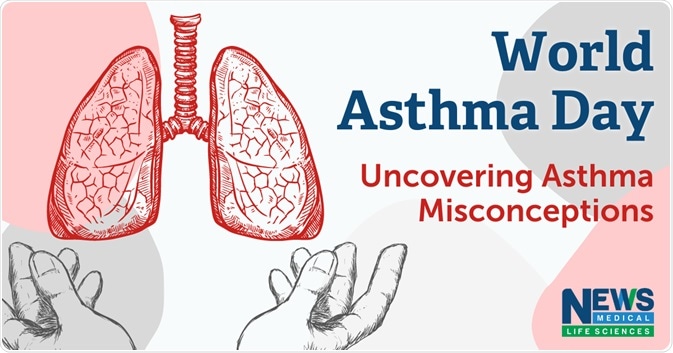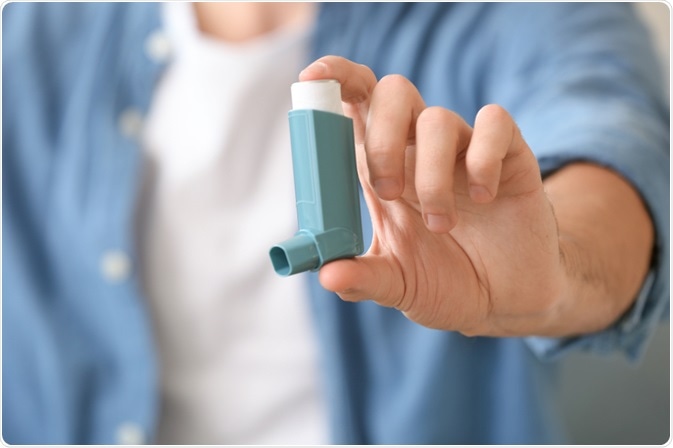
Climate change is already causing substantial changes concerning temperature, air, and water quality, and these are set to worsen within the next few decades. As a consequence, human health will almost certainly be impacted, especially with respect to respiratory allergies such as asthma.
Asthma is a chronic lung condition characterized by periods of wheezing, coughing, and difficulty breathing – especially when having an asthmatic attack. Such attacks can easily be managed by inhalers and minimized by long-term medication.
Asthma attacks tend to be caused by pollutants and allergens including pollen or animal dander, exhaust fumes (traffic pollution) and air pollution (such as those caused by wildfires), particulate matter, and high ozone levels. It is important to note that the prevalence of asthma has increased over the last few decades and is set to continue increasing.
 Asthma. Image Credit: Pixel-Shot/Shutterstock.com
Asthma. Image Credit: Pixel-Shot/Shutterstock.com
Climate change and asthma
Climate change will inevitably have an impact on overall human health. Changes in the ecosystem, for example, will affect vector transmission of certain diseases such as malaria and Lyme disease. Water quality and availability of freshwater will change thus increasing the likelihood of cholera and harmful algal blooms flourishing. Finally, air quality and levels of pollution of change this increasing the likelihood of respiratory allergies including asthma.
Specifically, with respect to air quality, climate change already has produced a notable effect, and this is only set to worsen, especially in developing nations as they become more dependent on fossil fuels. Even developed nations moving away from fossil fuels will still see the effect of global climate change on air quality due to temperature increases and additional devastating effects that can cause such as wildfires and intentional burning of forests/fields, smog (by traffic pollution), and global ground-level ozone levels.
Warmer climates also increase the likelihood of thunderstorms developing. These, when occurring in the high-pollen season, can exacerbate pollen, dust, and mold allergies increasing the prevalence of asthmatic attacks. Furthermore, warmer temperatures favor mold growth inside homes which can also be triggers for asthma and other allergies.

Climate Change. Image Credit: 24Novembers/Shutterstock.com
Why will pollen count increase?
Plants use atmospheric CO2 to photosynthesize and produce O2 to replenish the air. Whilst this is a natural way of “mopping up” excessive CO2 from the air to purify it (many nations are planting millions of trees to achieve this), it does present some notable challenges to pollen count.
Notably, the large amounts of atmospheric CO2 can lead to faster and larger growth in plants thus increasing the potency of pollen, as well as earlier and more intense flowering periods.
Lastly, the geographic distribution of certain plants and grasses from warmer countries will migrate away from the tropics to previously colder climates thus introducing novel allergenic plant species including ragweed (a highly allergenic plant).
It is not just trees and flowers that cause increased pollen counts. Many varieties of subtropical grasses which bloom in early spring will also be greatly affected by climate change. These grasses respond to warmer temperatures, and with increasing global temperatures these species will bloom earlier and more pronouncedly leading to earlier and more robust pollen counts.
Furthermore, such changes are more pronounced in urban areas with higher CO2 and temperature increases compared to rural areas. Thus, those living in cities may suffer more adversely than those in rural areas with respect to asthma as the climate continues to change.
In addition to increased levels of pollution and allergens, climate change is also thought to have an impact on the immune system. Higher temperatures are linked to increasing immunoglobulin binding (specifically IgE) and that specific pollens e.g., birch pollen bind with a higher affinity to IgE.
Increasing CO2 levels lead to increases in Amb a 1 (a pollen allergen) levels in ragweed which binds to IgE. Furthermore, as climate changes, the increased frequency of thunderstorms will further enhance levels of pollen caused by the mechanical and osmotic rupture of pollen leading to bioaerosol formation and spreading it more prevalently in the air.
It is not just pollen levels that are increasing, but other pollutants too that can cause asthma or exacerbate asthmatic attacks. Ozone inhalation is a known cause of acute lung dysfunction and increased airway responsiveness caused by airway injury and inflammation. Even an increase of 50 parts per billion (50ppb) for 1-hour leads to increased wheezing and chest tightening in children, with higher levels needing emergency medication.
In combination with air pollution caused by ozone, particulate matter, diesel exhaust particles (traffic pollution; smog), nitrogen and sulfur dioxides all increase the permeability of the airways which allow the infiltration and entry of allergens such as pollen and dust into the lungs causing an enhanced inflammation/asthmatic attacks in predisposed individuals. Furthermore, specific pollutants in the air can actually stick to the surface of pollen grains which can potentially enhance the allergenic properties of pollen, for example.
Summary
In summary, increasing global temperatures, CO2 & ozone levels will increase levels of pollution and allergens in the atmosphere which will increase the prevalence of asthma. Drastic measures to cut the levels of greenhouse gas emissions and pollution are needed immediately to ensure that not only does climate change not worsen, but the ill consequences to human health are also mitigated before substantial healthcare problems begin to materialize.
Though even the most drastic measures may take decades for such effects to minimize (and even then, many nations will continue to pump out greenhouse gas emissions and particulate matter), personal habits such as avoidance of pollen and keeping on top of long-term medication in addition to carrying emergency medication at all times are strongly needed by affected individuals.
References
- Wright, 2020. Influences of climate change on childhood asthma and allergy risk. Lancet Child Adolesc Health. 4(12):859-860. https://pubmed.ncbi.nlm.nih.gov/33217354/
- D’Amato et al, 2020. The effects of climate change on respiratory allergy and asthma induced by pollen and mold allergens. Allergy. 75(9):2219-2228. https://pubmed.ncbi.nlm.nih.gov/32589303/
- D’Amato et al, 2015. Effects on asthma and respiratory allergy of Climate change and air pollution. Multidiscip Respir Med. 22;10:39. https://pubmed.ncbi.nlm.nih.gov/26697186/
- Pool et al, 2019. Impact of weather and climate change with indoor and outdoor air quality in asthma: A Work Group Report of the AAAAI Environmental Exposure and Respiratory Health Committee. J Allergy Clin Immunol. 143(5):1702-1710. https://pubmed.ncbi.nlm.nih.gov/30826366/
Further Reading
- All Asthma Content
- Asthma
- Childhood Asthma
- Signs of Asthma Attack
- Asthma Symptoms
Last Updated: May 4, 2021

Written by
Dr. Osman Shabir
Osman is a Postdoctoral Research Associate at the University of Sheffield studying the impact of cardiovascular disease (atherosclerosis) on neurovascular function in vascular dementia and Alzheimer's disease using pre-clinical models and neuroimaging techniques. He is based in the Department of Infection, Immunity & Cardiovascular Disease in the Faculty of Medicine at Sheffield.
Source: Read Full Article
